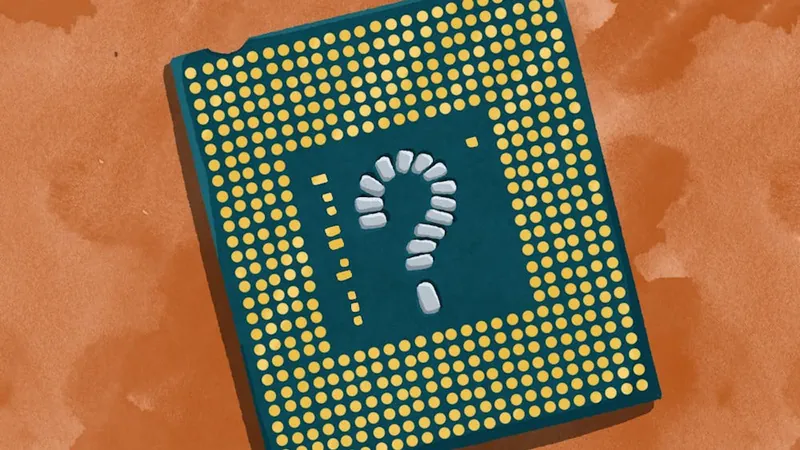
From Underdog to Powerhouse: How AMD Transformed into a Leading Contender in the x86 Processor Market
2024-11-27
Author: Amelia
Introduction
A decade ago, AMD was struggling in the shadows of Intel, often dismissed as a budget alternative in the x86 processor market. Fast forward to today, and AMD has emerged not only as a formidable competitor but also as a driving force in technological innovation.
The Rise and Fall: 2014
Back in early 2014, AMD, led by Rory Read, was on the decline, far from its glory days in the early 2000s when its Athlon 64 processors challenged Intel's dominance. By 2014, the company’s key desktop architecture, Piledriver, was known more for its inefficiency than performance, with CPUs that were as notorious for generating heat as they were for underperforming against Intel's celebrated Sandy and Ivy Bridge series. Consequently, AMD's revenues were dwindling, and its share of the market was minuscule, leaving a significant uphill battle to reclaim its position.
A New Leadership
This was a pivotal moment – one that was well understood by Dr. Lisa Su, an MIT engineer who would soon take the reins as CEO. Having joined AMD in 2012 as COO from Freescale Semiconductor, she was appointed with the monumental task of redefining AMD's strategy and public image. Under her leadership, AMD initiated a comprehensive rebuilding of its core architecture, transitioning from an affordable alternative to a genuine competitor in the market.
Transformation through Innovation
The transformation began with the launch of the Ryzen series in 2017, featuring the Zen microarchitecture. This groundbreaking design not only revitalized AMD’s desktop presence but laid the foundation for success across all major product categories. The rapid advancements continued with the introduction of the Ryzen 2000 series (Zen+) in 2018, pushing into datacenter territory with the first-gen Epyc processors.
Reaching New Heights: 2020 and Beyond
By 2020, AMD confidently unveiled Zen 3 and the Ryzen 5000 series, marking an impressive step forward in single-threaded performance – a domain where it previously lagged behind Intel. The success was palpable; AMD gained a significant share of both the desktop and datacenter markets, with data showing it claimed around 29% of the overall desktop market by Q3 2024.
Strategic Acquisitions
As AMD solidified its re-emergence, a critical acquisition played a key role in expanding its horizons. In February 2022, AMD acquired Xilinx for $50 billion, securing a foothold in the AI landscape. This strategic move positioned AMD to compete in an increasingly AI-centric tech environment, equipping its processors with improved capabilities to handle AI workloads directly.
Challenges Ahead
Despite its achievements, AMD continues to face formidable challenges, particularly in the graphics market. The company has made strides with its RDNA architectures, yet it still struggles to keep pace with Nvidia's established leadership in GPU performance, AI, and gaming. Additionally, while Ryzen Mobile processors have shown performance gains and enhanced energy efficiency, AMD remains a distant second to Intel in high-end laptops, where Intel's Evo platform sets a rigorous standard for premium devices.
Impact of Personnel Changes
Personnel changes in AMD over the last decade have also shaped its strategic journey. Notably, the departure of key figures like Jim Keller and Raja Koduri posed challenges. Keller was instrumental in the early success of AMD's CPU resurgence, while Koduri's absence left a gap in the graphics division just as AMD began gaining traction.
Conclusion: A New Era for AMD
Despite these hurdles, Dr. Lisa Su's leadership and vision have propelled AMD to new heights. The company has successfully established itself not just in desktop and server markets but is now recognized as a serious player across multiple sectors, including IoT and semi-custom products for gaming consoles.
The incredible turnaround of AMD encapsulates a decade marked by innovation, resilience, and strategic positioning. It has dramatically altered the landscape of the x86 marketplace, inciting competition and spurring technological advancements that benefit consumers worldwide. With the ever-evolving tech industry and the advent of AI, AMD's journey is undoubtedly one to watch as it continues to forge ahead, seeking to expand its footprint even further.
Whether AMD can sustain this momentum remains to be seen, but one thing is certain: the underdog story is far from over, and the company is ready for the next chapter.









 Brasil (PT)
Brasil (PT)
 Canada (EN)
Canada (EN)
 Chile (ES)
Chile (ES)
 España (ES)
España (ES)
 France (FR)
France (FR)
 Hong Kong (EN)
Hong Kong (EN)
 Italia (IT)
Italia (IT)
 日本 (JA)
日本 (JA)
 Magyarország (HU)
Magyarország (HU)
 Norge (NO)
Norge (NO)
 Polska (PL)
Polska (PL)
 Schweiz (DE)
Schweiz (DE)
 Singapore (EN)
Singapore (EN)
 Sverige (SV)
Sverige (SV)
 Suomi (FI)
Suomi (FI)
 Türkiye (TR)
Türkiye (TR)